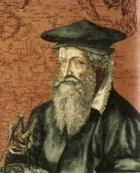Details
MERCATOR, G./ HONDIUS, J.
Published : Duisburg and then Amsterdam, (1595) 1609 or 1619.
Size : 14.9 x 18.5 inches. / 37.8 x 47.0 cm.
Colouring : Coloured.
A classic map of Africa. The map first appeared in Gerard Mercator’s Atlas sive Cosmographicae..., published posthumously in 1595. As stated in the title, this map is by Gerard Mercator's grandson, Gerard Mercator Jr. He extracted the information for this map from his famous grandfather's large world map of 1569. Mercator also used as sources the Waldseemuller and Gastaldi maps.
This fine, original colour example is based on Gerard Mercator's famous 1569 World Map. This particular map has a high degree of accuracy especially along the coastline that was unsurpassed by any other 16th century cartographer (Klemp).
Much of the interior of Africa defers to the traditions of Ptolemeus.
The Nile river is shown with the two lakes and the Mountains of the Moon across southern Africa. Mercator does show European advance into the interior. For example, Mercator shows Portuguese exploration up the Cuama (Zambezi) River into the interior of south central Africa in the region of Monomotapa or Benamataxa, as he named it on his map. "Ca. Portogal" (the Portuguese Fort) is placed on the map within the junction of the Spirito and Cuama rivers (Betz).
Mercator tried to adhere to a more scientific approach and did not include the numerous beasts and mythical creature of other cartographers. The cartouche is quite decorative with fruit and two satyrs.
The fine script is superb and the sea has Mercator's signature "miore" pattern.
Betz Map 31. Tooley, p. 74-75 and Map 55. Norwich, map 21
Condition : A good and strong impression. In very good condition. French text on verso.
Additional Information
| SKU | xxbt14 |
|---|---|
| Picture Size | 37,80 x 47 cm |
| Specification | Map |
| technic | Engraving |
| Artist | Gerard Mercator |
| period | 16th Century |
| School | Flemish |
| subject | Other |
| rating | **** |
Gerard Mercator (1512 – 1594)
 Mercator is a seminal figure in the history of cartography. Mercator's calculations and map designs redefined the 16th century concept of cartography and were the first to break away from the Ptolemy model. Many of his systems of measurement, such as the Mercator Projection, are still in use today. Despite his prominence as a cartographer, he started his career as a crafter of scientific instruments.
Mercator is a seminal figure in the history of cartography. Mercator's calculations and map designs redefined the 16th century concept of cartography and were the first to break away from the Ptolemy model. Many of his systems of measurement, such as the Mercator Projection, are still in use today. Despite his prominence as a cartographer, he started his career as a crafter of scientific instruments.
He did not construct his first map until 1540, when he made two maps, one of Flanders and another of Palestine. These two impressive works earned him the patronage of the Emperor Charles V, for whom he construed a globe and several large scale maps. Despite this imperial patronage, Mercator was accused of heresy and in 1552 fled to Duisburg. In Duisburg he set himself up as a cartographer and began work on his revised edition of Ptolemy's Geographia. This three volume work was the first book to be called an "Atlas", after the Titan and King of Mauritania. F
ollowing Mercator's death his descendants took over his firm but languished because of heavy competition from the Ortelius firm. It was not until Mercator's plates were purchased and republished ( Mercator / Hondius ) by Henricus Hondius and Jan Jansson that Mercator's position as the preeminent cartographer of the age was re-established
All the items are guaranteed to be originals and as described.
A letter of authenticity is added by simple request.
Items may be returned within 15 days after arrival.
I ship worldwide and provide Insurance and other delivery options.
All items can be purchased instantly at the listed prices,
on reservation of errors in price or availibility..











 Facebook
Facebook Twitter
Twitter Subscribe us
Subscribe us Flickr
Flickr




